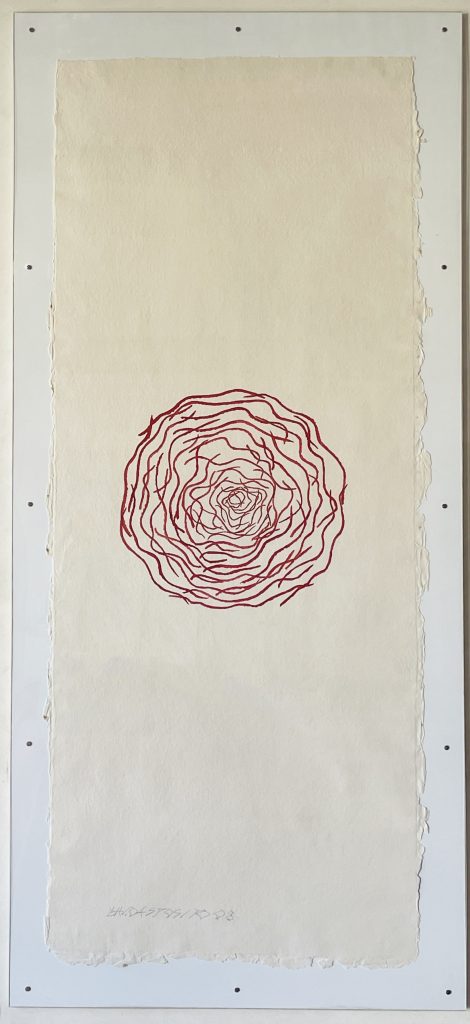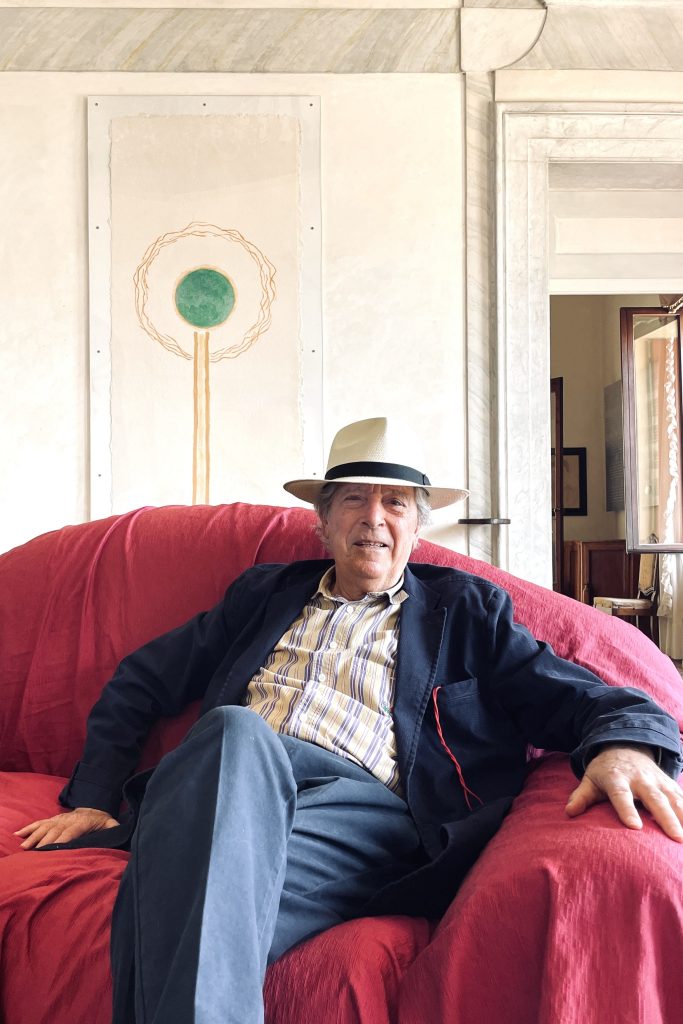
Diego Esposito

Diego Esposito (Teramo 1940) lives and works between Milan and Venice.
Raised in the historic San Bernardo district, he studied and trained in Naples where he assiduously frequented the rooms of Pompeii’s frescoes, “There I understood that between ancient and modern art there is a contemporaneity.”
From 1968 to 1972 he resided in the United States where he held his first solo exhibition at the Art Alliance in Philadelphia (1969). In 1972 he returned to Italy, in Milan, and his art showed a marked interest in color, invested with symbolic and alchemical values. In 1973 he participated in “Italy Two. Art around ’70” curated by Alberto Boatto and Filiberto Menna in Philadelphia and, in the following two years, he held two solo shows at Galleria dell’Ariete in Milan, exhibited at Galleria La Bertesca in Genoa and in 1975 opened at Galleria Toselli in Milan and at Banco (Massimo Minini) in Brescia. In the following years he traveled to the Mediterranean and the Middle East, landing in 1977 in Stromboli where he conceived the idea of “The Impossible House,” exhibited at Galleria Paola Betti in Milan. The same gallery will host another solo exhibition of the artist in 1980 entitled “The Flight of the Nocturnal Bird”: here the conceptual vein that characterized Esposito’s last works is diluted and color, drawing, graffiti, photography and folded canvases re-emerge. Mediterranean culture and travels to Greece and Turkey also inspired later works in the 1980s in which the cadmium yellow artificial light source is present. In 1981 he participated in “Lines of Artistic Research in Italy 1960/1980” in Rome and exhibited at the Pero Gallery in Milan. This was followed by the Stanze dell’aria, del fuoco, dell’acqua e della terra (1989-1990) at Villa Imbarcati in Pistoia, and in 1985 he began making the Corpi neri-Oggetti invisibili, born from the combination of mosaic and metal. In 1986 he sinks the polychrome ceramic Invisible Objects tilted northwestward in the Bosphorus Strait, after exhibiting it for three hours at Leander’s Tower in Istanbul, Turkey, achieving total invisibility of the work of art; conversely, in 1987 the ovoid mosaic Gold resurfaces at the Punta della Dogana in Venice. He held solo shows at the Castello Estense in Mesola in 1991, at the Fondazione Mudima in Milan in 1993, and at Palazzo Fabroni in Pistoia curated by Bruno Corà in 1998. In 2000 he is invited to exhibit at the University Art Gallery UCSD in San Diego (USA) and in 2001 he presents his work at the Ludwigsburg Kunstverein in Ludwigsburg (Germany) and makes a permanent work for the Centro Arte Contemporanea Luigi Pecci in Prato. In 2003 he opened an anthological exhibition at the Pinacoteca Civica and Villeroy & Boch in Teramo and participated in the “Haifa Second International Installation Triennale” in Haifa, Israel. In 2004 he is invited as an artist-in-residence to Kanazawa (Japan) by the 21st Century Museum of Contemporary Art and Kanazawa Art University, where he makes the permanent sculpture Celato/Sveled. The following year he is invited by the Ihn Gallery in Seoul (South Korea) for a solo exhibition.
In 2006 he participated in the exhibition “Italian Sculpture of the 20th Century” at the Fondazione A. Pomodoro in Milan and at the “12th International Biennial of Sculpture” in Carrara, in 2008 at the exhibition “Constants of the Classical in the Art of the 20th and 21st Centuries” at the Puglisi Cosentino Foundation in Catania, in 2009 he presented an important series of watercolors in a solo show at the Giacomo Guidi Gallery in Rome, and in 2014 he created a vast wall decoration at the rectory hall of the University of Teramo. Noteworthy is the Latitude/Longitude cycle of works, on which Esposito worked from 2001 to 2018 and which involves the permanent placement of works in contemporary art museums on different continents. Nine have currently been made: at the Center for Contemporary Art ‘Luigi Pecci’ in Prato (2001), at the Oriental Land Park in Shanghai, China (2007), at the Caraffa Museum Park in Córdoba, Argentina (2010), at the Centro Cultural Ccori Wasi in Lima, Peru (2011), at the Muryokoin Temple, Koyasan in Japan (2015), at the University of Marseille in France (2015), in the garden of the Cini Foundation on the Island of San Giorgio in Venice (2016), at the University of Teramo (2017) at the Zuratkul National Park, Satka in the Russian Urals (2018).
In 2024 he began his collaboration with Allegra Ravizza Gallery, which in the same year inaugurated his solo exhibition “Il Luogo Invisibile” curated by Marco Meneguzzo in the splendid venue of Villa Ca’Amata in Castelfranco Veneto.